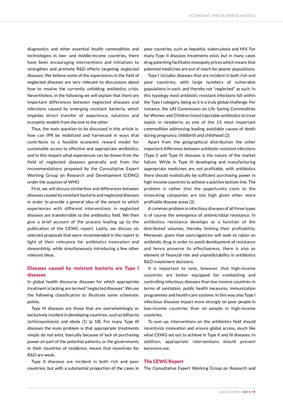
diagnostics and other essential health commodities and
technologies in low- and middle-income countries, there
have been encouraging interventions and initiatives to
strengthen and promote R&D efforts targeting neglected
diseases. We believe some of the experiences in the field of
neglected diseases are very relevant to discussions about
how to resolve the currently unfolding antibiotics crisis.
Nevertheless, in the following we will explain that there are
important differences between neglected diseases and
infections caused by emerging resistant bacteria, which
impedes direct transfer of experience, solutions and
economic models from the one to the other.
Thus, the main question to be discussed in this article is:
how can IPR be mobilized and harnessed in ways that
contribute to a feasible economic reward model for
sustainable access to effective and appropriate antibiotics,
and in this respect what experiences can be drawn from the
field of neglected diseases generally and from the
recommendations proposed by the Consultative Expert
Working Group on Research and Development (CEWG)
under the auspices of WHO.
First, we will discuss similarities and differences between
diseases caused by resistant bacteria and neglected diseases
in order to provide a general idea of the extent to which
experiences with different interventions in neglected
diseases are transferrable to the antibiotics field. We then
give a brief account of the process leading up to the
publication of the CEWG report. Lastly, we discuss six
selected proposals that were recommended in the report in
light of their relevance for antibiotics innovation and
stewardship, while simultaneously introducing a few other
relevant ideas.
Diseases caused by resistant bacteria are Type I
diseases
In global health discourse diseases for which appropriate
treatment is lacking are termed "neglected diseases". We use
the following classification to illustrate some schematic
points.
Type III diseases are those that are overwhelmingly or
exclusively incident in developing countries, such as bilharzia
(schistosomiasis) and ebola (1) (p 18). For many Type III
diseases the main problem is that appropriate treatments
simply do not exist, basically because of lack of purchasing
power on part of the potential patients, or the governments
in their countries of residence, means that incentives for
R&D are weak.
Type II diseases are incident in both rich and poor
countries, but with a substantial proportion of the cases in
poor countries, such as hepatitis, tuberculosis and HIV. For
many Type II diseases treatments exist, but in many cases
drug patenting facilitates monopoly prices which means that
patented medicines are out of reach for poorer populations.
Type I includes diseases that are incident in both rich and
poor countries, with large numbers of vulnerable
populations in each, and thereby not "neglected" as such. In
this typology most antibiotic resistant infections fall within
the Type I category, being as it is a truly global challenge. For
instance, the UN Commission on Life Saving Commodities
for Women and Children listed injectable antibiotics to treat
sepsis in newborns as one of the 13 most important
commodities addressing leading avoidable causes of death
during pregnancy, childbirth and childhood (2).
Apart from the geographical distribution the other
important difference between antibiotic resistant infections
(Type I) and Type III diseases is the nature of the market
failure. While in Type III developing and manufacturing
appropriate medicines are not profitable, with antibiotics
there should realistically be sufficient purchasing power in
high-income countries to achieve a positive bottom line. The
problem is rather that the opportunity costs to the
innovating companies are too high given other more
profitable disease areas (3).
A common problem in infectious diseases of all three types
is of course the emergence of antimicrobial resistance. In
antibiotics resistance develops as a function of the
distributed volumes, thereby limiting their profitability.
Moreover, given that users/agencies will seek to ration an
antibiotic drug in order to avoid development of resistance
and hence preserve its effectiveness, there is also an
element of financial risk and unpredictability in antibiotics
R&D investment decisions.
It is important to note, however, that high-income
countries are better equipped for combatting and
controlling infectious diseases than low-income countries in
terms of sanitation, public health measures, immunization
programmes and health-care systems. In this way also Type I
infectious diseases impact more strongly on poor people in
low-income countries than on people in high-income
countries.
To sum up, interventions on the antibiotics field should
incentivize innovation and ensure global access, much like
what CEWG set out to achieve in Type II and III diseases. In
addition, appropriate interventions should prevent
excessive use.
The CEWG Report
The Consultative Expert Working Group on Research and
ECONOMIC AND BUSINESS MODELS
AMR CONTROL 2015 19